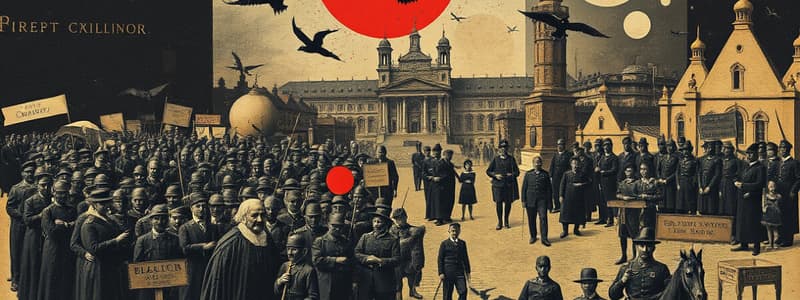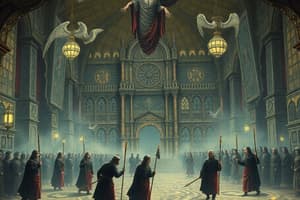Podcast
Questions and Answers
What event marked the beginning of significant social change in England in 1381?
What event marked the beginning of significant social change in England in 1381?
- The establishment of the Statute of Laborers
- The Peasants’ Revolt (correct)
- The Plague outbreak
- The execution of Wat Tyler
Which economic condition prevailed in Eastern Europe after the plague?
Which economic condition prevailed in Eastern Europe after the plague?
- High population density encouraging urban growth
- An extractive labor market with increased serfdom (correct)
- A booming agricultural export market promoting worker rights
- Labor scarcity leading to increased freedom for workers
What was a significant consequence of the Western demand for agricultural goods from Eastern Europe after 1500?
What was a significant consequence of the Western demand for agricultural goods from Eastern Europe after 1500?
- Immediate improvement in workers' living standards
- Increased control of landlords over labor forces (correct)
- Eastern workers gained greater autonomy
- Eastern landlords reduced their landholdings
How did the Peasants’ Revolt affect the Statute of Laborers in England?
How did the Peasants’ Revolt affect the Statute of Laborers in England?
In which region did the phenomenon known as the Second Serfdom occur?
In which region did the phenomenon known as the Second Serfdom occur?
What happened to the amount of unpaid labor required from tenants in Mecklenberg between 1500 and 1600?
What happened to the amount of unpaid labor required from tenants in Mecklenberg between 1500 and 1600?
Which crops were primarily exported from Eastern Europe to meet Western demands?
Which crops were primarily exported from Eastern Europe to meet Western demands?
What characterized the labor market in England following the Peasants’ Revolt?
What characterized the labor market in England following the Peasants’ Revolt?
What primarily drives the small institutional differences that lead to the divergence of societies?
What primarily drives the small institutional differences that lead to the divergence of societies?
How can differences between societies become pronounced over time?
How can differences between societies become pronounced over time?
Which factor does NOT contribute to the institutional differences observed among societies?
Which factor does NOT contribute to the institutional differences observed among societies?
What is a consequence of institutional drift during critical junctures?
What is a consequence of institutional drift during critical junctures?
What distinguishes how different societies manage resources like stolen loot or shared kills?
What distinguishes how different societies manage resources like stolen loot or shared kills?
What best describes the relationship between Crown and Parliament in different societies?
What best describes the relationship between Crown and Parliament in different societies?
How do societies with simpler structures, like hunter-gatherers, create their institutions?
How do societies with simpler structures, like hunter-gatherers, create their institutions?
What is the role of critical junctures in the context of institutional development?
What is the role of critical junctures in the context of institutional development?
What was the primary method of transmission of the plague?
What was the primary method of transmission of the plague?
What were the earliest symptoms of the plague as observed in Florence?
What were the earliest symptoms of the plague as observed in Florence?
How long did death typically occur after the appearance of symptoms?
How long did death typically occur after the appearance of symptoms?
What did King Edward III ask the Archbishop of Canterbury to do in response to the plague?
What did King Edward III ask the Archbishop of Canterbury to do in response to the plague?
What did Ralph of Shrewsbury say about God's actions in relation to the plague?
What did Ralph of Shrewsbury say about God's actions in relation to the plague?
What role did Genoese traders play in the spread of the plague?
What role did Genoese traders play in the spread of the plague?
What demographic impact did the plague have on areas it affected?
What demographic impact did the plague have on areas it affected?
How was the plague initially perceived in comparison to its form in the East?
How was the plague initially perceived in comparison to its form in the East?
What change occurred in Hungary regarding unpaid labor services from 1514 to the end of the century?
What change occurred in Hungary regarding unpaid labor services from 1514 to the end of the century?
By 1600, what percentage of the rural population in Hungary were serfs subject to labor demands?
By 1600, what percentage of the rural population in Hungary were serfs subject to labor demands?
What was a key difference in the economic context between Western and Eastern Europe by 1600?
What was a key difference in the economic context between Western and Eastern Europe by 1600?
What factor contributed to the divergence in institutional development between East and West?
What factor contributed to the divergence in institutional development between East and West?
What historical event is cited as a vivid example of a critical juncture?
What historical event is cited as a vivid example of a critical juncture?
How did critical junctures, like the Black Death, affect institutions?
How did critical junctures, like the Black Death, affect institutions?
What was a significant outcome of the Black Death in Western Europe?
What was a significant outcome of the Black Death in Western Europe?
What aspect of English history in the seventeenth century is highlighted as unique?
What aspect of English history in the seventeenth century is highlighted as unique?
What was the role of serfs in the Eastern European economy compared to their Western counterparts?
What was the role of serfs in the Eastern European economy compared to their Western counterparts?
How did the political conditions in 1600 differ between England and France/Spain?
How did the political conditions in 1600 differ between England and France/Spain?
What was the effect of the rise of Atlantic trade on English political institutions?
What was the effect of the rise of Atlantic trade on English political institutions?
What characterizes the critical junctures in history according to the provided content?
What characterizes the critical junctures in history according to the provided content?
What key event illustrated the contingent nature of England’s political history?
What key event illustrated the contingent nature of England’s political history?
What factor emboldened the merchants opposing the Crown in England?
What factor emboldened the merchants opposing the Crown in England?
What was a characteristic of the English navy prior to the Glorious Revolution?
What was a characteristic of the English navy prior to the Glorious Revolution?
What implication did the economic opportunities of the 17th to 19th centuries have for Eastern and Western Europe?
What implication did the economic opportunities of the 17th to 19th centuries have for Eastern and Western Europe?
Flashcards are hidden until you start studying
Study Notes
The Black Death and its Spread
- The Bubonic Plague, known as the Black Death, arrived at Tana (Black Sea) in 1346, transmitted by rats from traders along the Silk Road.
- Genoese traders aided in spreading the plague across the Mediterranean, reaching Constantinople by early 1347 and continuing into France, North Africa, and Italy by spring 1348.
- The plague decimated approximately half of the population in affected regions.
- Giovanni Boccaccio’s observations in Florence highlighted the rapid onset of symptoms, including swellings and dark blotches, often resulting in death within three days.
Societal Responses and Changes
- In England, awareness of the plague led King Edward III to request organized prayers to address the impending crisis.
- The Peasants' Revolt of 1381, sparked by social unrest post-plague, saw Wat Tyler leading a rebellion, capturing London but ultimately being defeated.
- Following the plague, labor shortages resulted in increased wages and the decline of feudal labor services, pushing towards a more inclusive labor market in England.
Divergence Between Eastern and Western Europe
- Demographic impacts from the plague were similar across Europe, with labor scarcity prompting demands for greater freedoms.
- In Eastern Europe, nobles managed to maintain control over labor markets, leading to the emergence of the Second Serfdom, where serfs faced encroaching obligations and increased labor demands.
- By 1600, significant institutional differences had emerged, with Western workers gaining freedoms while Eastern serfs remained bound to oppressive systems.
The Impact of Critical Junctures
- The Black Death represented a critical juncture, disrupting existing political and economic balances, with outcomes varying by region.
- In Western Europe, the upheaval led to the dissolution of feudalism, while Eastern Europe saw intensified extractive institutions.
- Understanding these historical events elucidates the reasons behind disparities in poverty and prosperity among nations.
Emergence of Inclusive Institutions in England
- England saw a breakthrough in sustained economic growth in the 17th century, attributed to unique institutional developments.
- Critical differences between Eastern and Western Europe stemmed from the balance of power between the Crown and Parliament since the 14th century.
- Institutional drift over time, shaped by minor initial differences, led to significant variations in societal structures despite similar beginnings.
Consequences of Historical Contingency
- Institutional development is influenced by historical weight, with outcomes shaped by the power dynamics and alliances formed during critical junctures.
- The Glorious Revolution of 1688 in England illustrates how contingent events led to the triumph of groups advocating for limiting the Crown's power.
- The rise of Atlantic trade empowered merchants, fundamentally altering England's political landscape despite initial challenges in establishing a powerful navy.
Studying That Suits You
Use AI to generate personalized quizzes and flashcards to suit your learning preferences.





